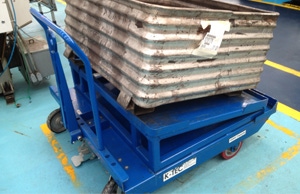GKN Phasing Out ForkliftsGKN Phasing Out Forklifts
The supplier will migrate to hand-trucks and, where feasible, automated guided vehicles. “You have to re-engineer the whole site,” Global Communications Director Paul Dinwiddy says.


CELAYA, GUANAJUATO, Mexico – GKN Driveline can expect to save on yellow paint at its operations here because it may no longer need those ubiquitous plant-floor caution lines.
The Tier 1 supplier is on a fast track to reduce or eliminate forklifts from the pedestrian-traffic areas of its plants. GKN will use hand trucks instead and, where feasible, automated guided vehicles (AGVs).
GKN transitioning to hand trucks from forklifts.
“That’s the plan for the next two years,” Manufacturing Director Fermin Moreno says. “We are working toward that on a daily basis.”
The idea comes from half a world away. At GKN’s operations in India, “We had a lot of accidents related to forklifts there,” says Global Communications Director Paul Dinwiddy.
So the supplier launched a concerted effort to phase out forklifts.
“Accidents fell dramatically,” he says, adding GKN then realized it could affect change across its 22-nation network of plants, engineering centers and product-development sites that employ some 22,000 workers.
“It worked in India, so it can work anywhere,” Dinwiddy says. “So gradually, we are (accepting) the challenge.”
As new sites are built or existing plants are expanded, they are reconfigured to accommodate the change. This is happening here now, as GKN is installing capacity to enable an annual output of 9 million units by 2014, an increase of 2.5 million units from the current level.
“The key issue is health and safety,” GKN’s Paul Dinwiddy says.
“You have to re-engineer the whole site,” Dinwiddy tells WardsAuto during a media tour of GKN facilities. “You can’t just go in there and start pushing around these trolleys.”
The amount of material moved at any one time must be reduced so hand-trucks are not too heavy. Distances also need to be considered.
At GKN’s updated Indian plants, material no longer is stacked as it was when forklifts were in vogue. “It allows us to reduce our inventory,” Dinwiddy says. “It kind of makes us more disciplined.”
He is vague on bottom-line impact. “The key issue is health and safety,” Dinwiddy says. “You can’t put a value on that. There probably is a slight increase in cost.”
The idea is not new. Auto makers such as Ford have been migrating away from forklift use for several years.
Despite the extensive safety regulations and driver certification requirements surrounding forklift use in the U.S., the nation’s Occupational Health and Safety Admin. every year records about 85 fatalities and nearly 35,000 serious injuries related to forklift operation.
Plant mishaps account for 42% of the accident total, followed by construction-site calamities with 23.8%.
Tipovers are the most common type of forklift accident at 42%. Incidents in which victims somehow are crushed rank second at 36%.
About the Author
You May Also Like

